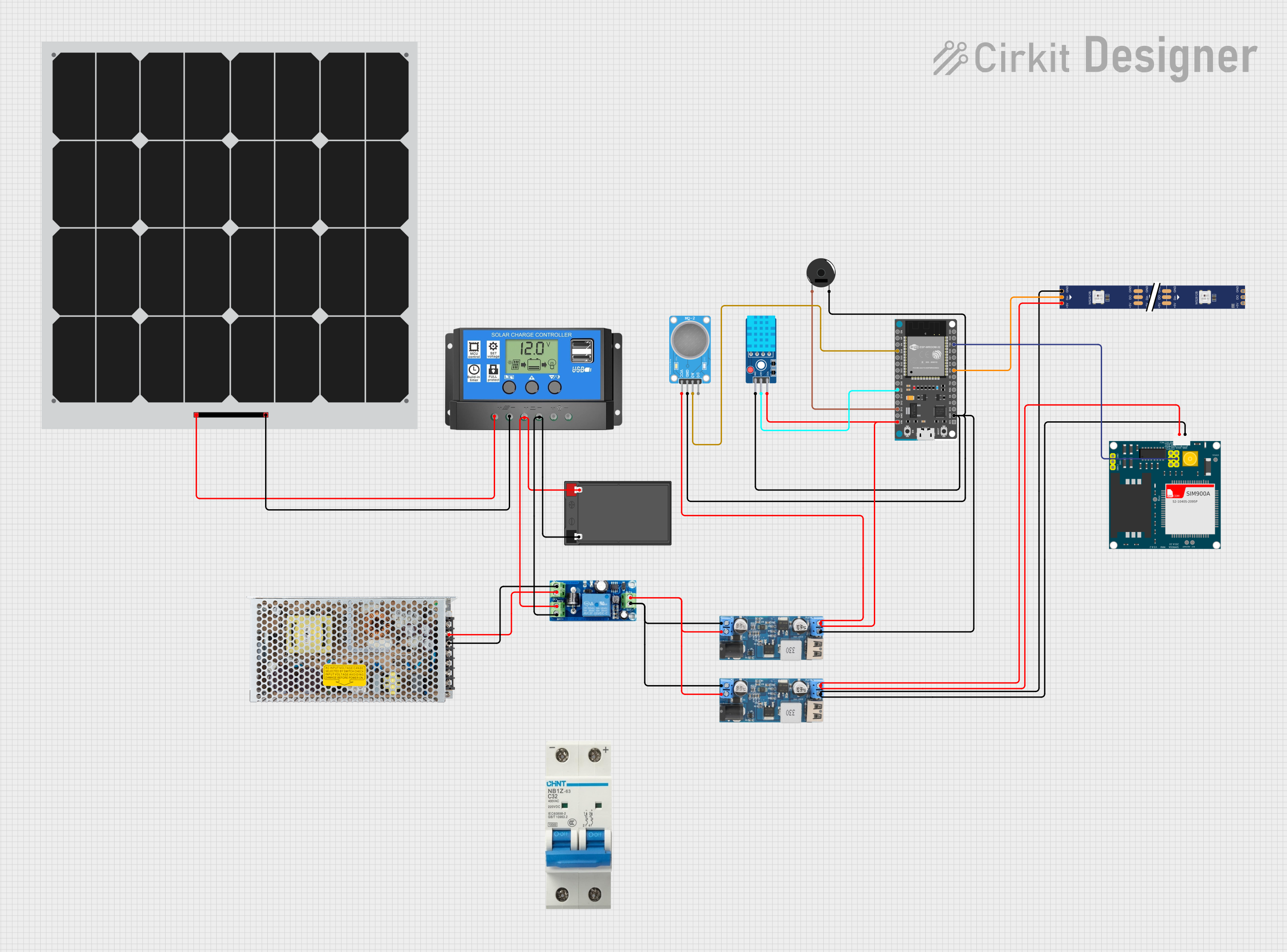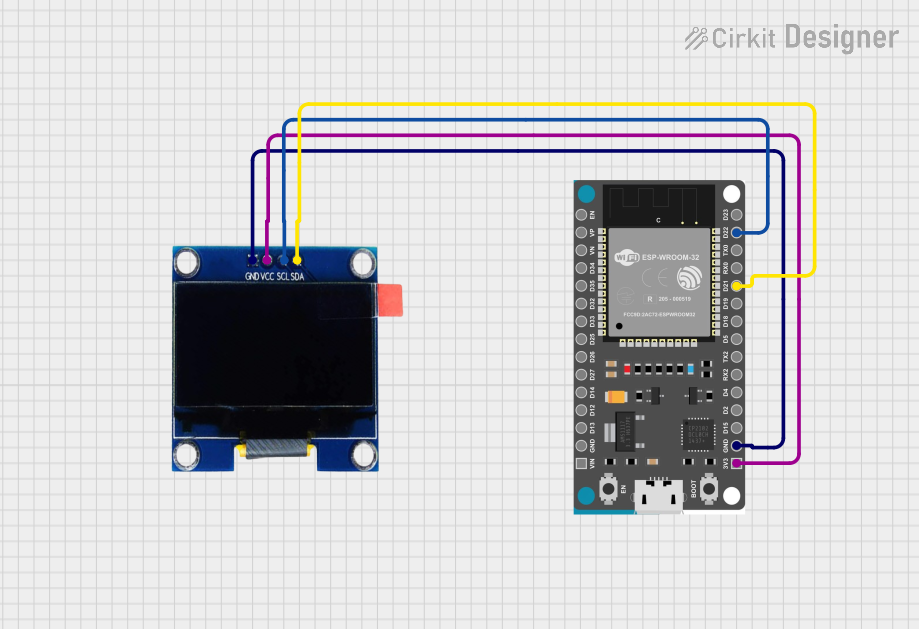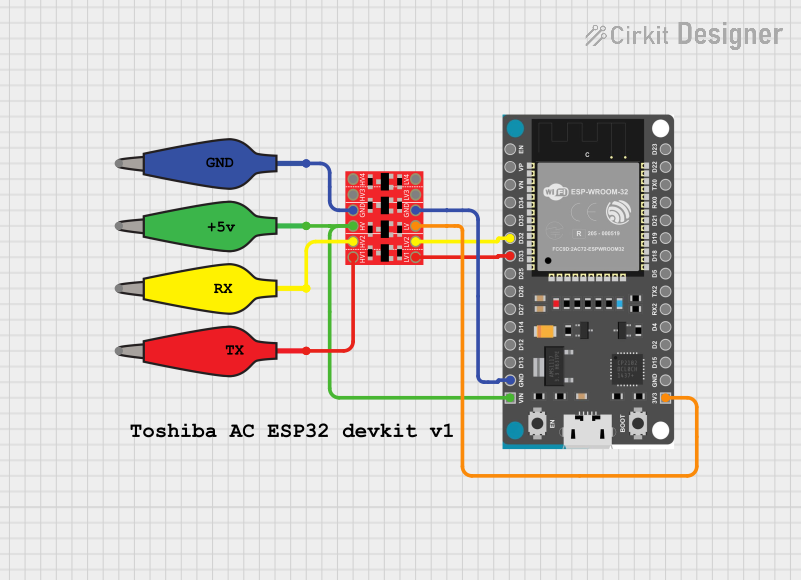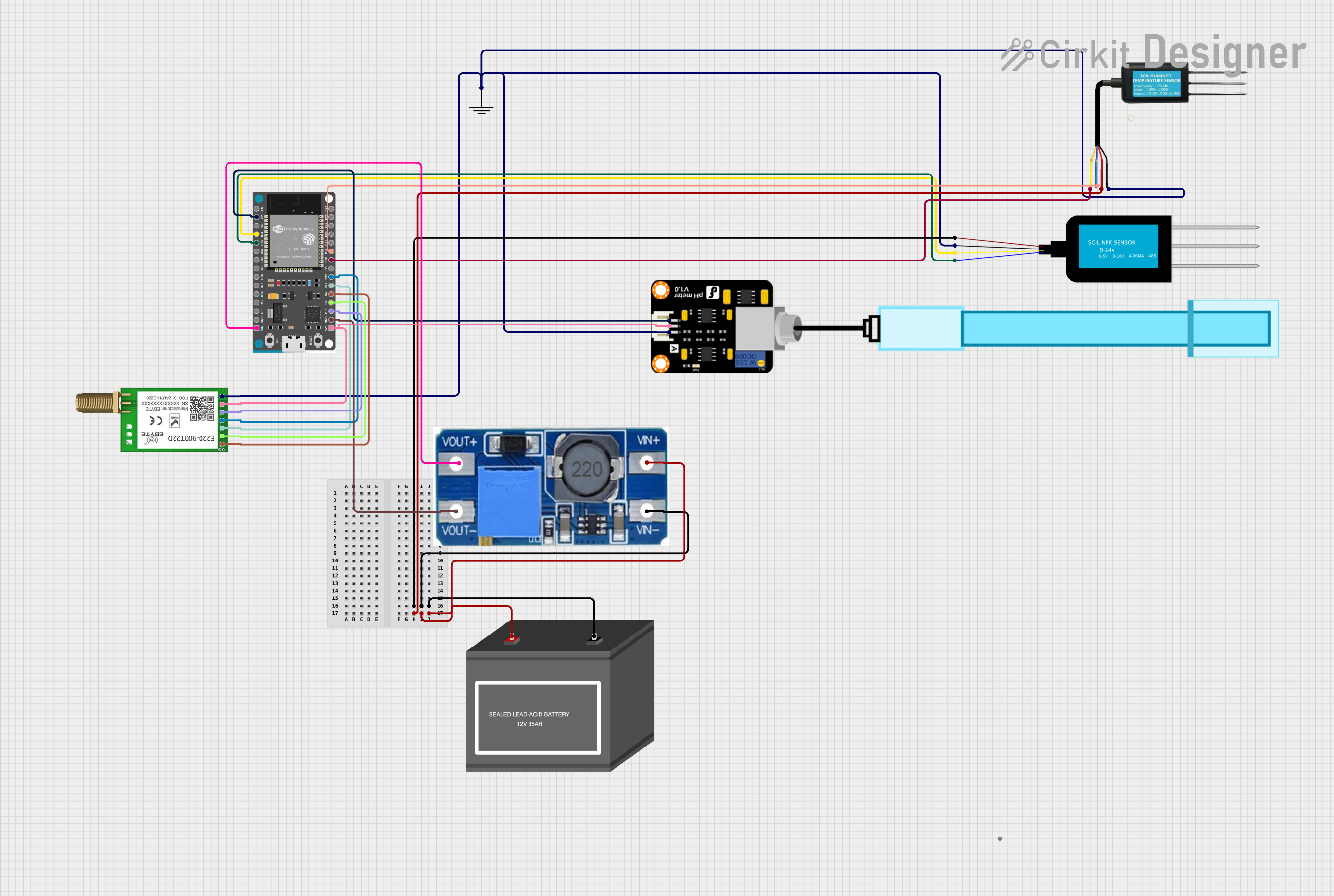
How to Use ESP32 devkit v1: Examples, Pinouts, and Specs

 Design with ESP32 devkit v1 in Cirkit Designer
Design with ESP32 devkit v1 in Cirkit DesignerIntroduction
The ESP32 DevKit V1, manufactured by Espressif, is a versatile development board built around the powerful ESP32 chip. It features integrated Wi-Fi and Bluetooth capabilities, making it an excellent choice for Internet of Things (IoT) applications, smart devices, and rapid prototyping. The board is compact, cost-effective, and supports a wide range of peripherals, making it suitable for both beginners and experienced developers.
Explore Projects Built with ESP32 devkit v1

 Open Project in Cirkit Designer
Open Project in Cirkit Designer
 Open Project in Cirkit Designer
Open Project in Cirkit Designer
 Open Project in Cirkit Designer
Open Project in Cirkit Designer
 Open Project in Cirkit Designer
Open Project in Cirkit DesignerExplore Projects Built with ESP32 devkit v1

 Open Project in Cirkit Designer
Open Project in Cirkit Designer
 Open Project in Cirkit Designer
Open Project in Cirkit Designer
 Open Project in Cirkit Designer
Open Project in Cirkit Designer
 Open Project in Cirkit Designer
Open Project in Cirkit DesignerCommon Applications and Use Cases
- IoT devices and smart home automation
- Wireless sensor networks
- Wearable technology
- Robotics and automation systems
- Prototyping for Wi-Fi and Bluetooth-enabled projects
- Data logging and remote monitoring
Technical Specifications
The ESP32 DevKit V1 is equipped with the ESP32-WROOM-32 module, which includes a dual-core processor and a rich set of peripherals. Below are the key technical details:
Key Technical Details
| Specification | Value |
|---|---|
| Microcontroller | ESP32 (dual-core Xtensa LX6) |
| Clock Speed | Up to 240 MHz |
| Flash Memory | 4 MB (varies by model) |
| SRAM | 520 KB |
| Wi-Fi | 802.11 b/g/n (2.4 GHz) |
| Bluetooth | v4.2 BR/EDR and BLE |
| Operating Voltage | 3.3V |
| Input Voltage (VIN) | 5V (via USB or external power supply) |
| GPIO Pins | 30 (varies by board version) |
| ADC Channels | 18 (12-bit resolution) |
| DAC Channels | 2 |
| Communication Interfaces | UART, SPI, I2C, I2S, CAN, PWM |
| Power Consumption | Ultra-low power (varies by mode) |
| Dimensions | ~54 mm x 27 mm |
Pin Configuration and Descriptions
The ESP32 DevKit V1 has a 30-pin layout. Below is the pin configuration:
| Pin Number | Pin Name | Description |
|---|---|---|
| 1 | EN | Enable pin (active high) |
| 2 | IO1 (TX0) | UART0 Transmit (TX) |
| 3 | IO3 (RX0) | UART0 Receive (RX) |
| 4 | IO4 | GPIO4, PWM, ADC |
| 5 | IO5 | GPIO5, PWM, ADC |
| 6 | GND | Ground |
| 7 | IO18 | GPIO18, SPI_CLK |
| 8 | IO19 | GPIO19, SPI_MISO |
| 9 | IO21 | GPIO21, I2C SDA |
| 10 | IO22 | GPIO22, I2C SCL |
| 11 | 3V3 | 3.3V Power Output |
| 12 | GND | Ground |
| 13 | IO23 | GPIO23, SPI_MOSI |
| 14 | IO25 | GPIO25, DAC1, ADC |
| 15 | IO26 | GPIO26, DAC2, ADC |
| 16 | IO27 | GPIO27, ADC |
| 17 | IO32 | GPIO32, ADC |
| 18 | IO33 | GPIO33, ADC |
| 19 | IO34 | GPIO34, ADC (input only) |
| 20 | IO35 | GPIO35, ADC (input only) |
| 21 | VIN | 5V Input Power |
| 22 | IO2 | GPIO2, PWM, ADC |
| 23 | IO15 | GPIO15, PWM, ADC |
| 24 | IO13 | GPIO13, PWM, ADC |
| 25 | IO12 | GPIO12, PWM, ADC |
| 26 | IO14 | GPIO14, PWM, ADC |
| 27 | IO16 | GPIO16, UART2 TX |
| 28 | IO17 | GPIO17, UART2 RX |
| 29 | IO0 | GPIO0, Boot Mode Selection |
| 30 | IO36 (VP) | GPIO36, ADC (input only) |
Usage Instructions
The ESP32 DevKit V1 is easy to use and can be programmed using the Arduino IDE, ESP-IDF, or other development environments. Below are the steps to get started:
How to Use the Component in a Circuit
Powering the Board:
- Connect the board to your computer via a micro-USB cable. This provides both power and a communication interface for programming.
- Alternatively, supply 5V to the VIN pin and GND to power the board externally.
Programming the Board:
- Install the Arduino IDE and add the ESP32 board support package.
- Select the correct board (
ESP32 Dev Module) and port in the Arduino IDE. - Write your code and upload it to the board.
Connecting Peripherals:
- Use the GPIO pins to connect sensors, actuators, or other peripherals.
- Ensure that the voltage levels of connected devices are compatible with the ESP32 (3.3V logic).
Important Considerations and Best Practices
- Voltage Levels: The ESP32 operates at 3.3V. Avoid connecting 5V signals directly to the GPIO pins to prevent damage.
- Boot Mode: GPIO0 must be pulled low during boot to enter programming mode.
- Power Supply: Ensure a stable power supply, especially when using Wi-Fi or Bluetooth, as these features can cause power spikes.
- Pin Multiplexing: Many pins have multiple functions. Refer to the datasheet to avoid conflicts when using peripherals.
Example Code for Arduino IDE
Below is an example code to blink an LED connected to GPIO2:
// Define the GPIO pin for the LED
#define LED_PIN 2
void setup() {
// Set the LED pin as an output
pinMode(LED_PIN, OUTPUT);
}
void loop() {
// Turn the LED on
digitalWrite(LED_PIN, HIGH);
delay(1000); // Wait for 1 second
// Turn the LED off
digitalWrite(LED_PIN, LOW);
delay(1000); // Wait for 1 second
}
Troubleshooting and FAQs
Common Issues and Solutions
Board Not Detected in Arduino IDE:
- Ensure the correct USB driver is installed for the ESP32.
- Check the USB cable and port connection.
- Select the correct board and port in the Arduino IDE.
Upload Fails with Timeout Error:
- Press and hold the
BOOTbutton on the board while uploading the code. - Ensure GPIO0 is pulled low during programming.
- Press and hold the
Wi-Fi Connection Issues:
- Verify the SSID and password in your code.
- Ensure the router is operating on the 2.4 GHz band (ESP32 does not support 5 GHz).
Random Resets or Instability:
- Check the power supply for stability. Use a capacitor if necessary.
- Avoid using GPIO pins that are reserved for internal functions.
FAQs
Q: Can I use the ESP32 DevKit V1 with a 5V sensor?
A: Yes, but you will need a level shifter to convert the 5V signal to 3.3V.
Q: How do I reset the board?
A: Press the EN button to reset the board.
Q: Can I use both Wi-Fi and Bluetooth simultaneously?
A: Yes, the ESP32 supports simultaneous use of Wi-Fi and Bluetooth, but it may increase power consumption.
Q: What is the maximum current draw of the ESP32?
A: The ESP32 can draw up to 500 mA during peak operation (e.g., Wi-Fi transmission). Ensure your power supply can handle this.
This concludes the documentation for the ESP32 DevKit V1. For more details, refer to the official Espressif datasheet and user guide.